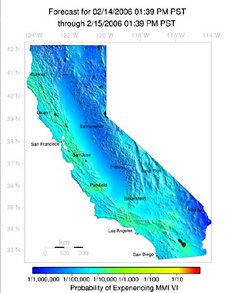
|
||||||||||||||||
|
|

|
|
|
Predictions and Warning Systems
What seismologists do know is that earthquakes occur on faults . Beyond that, they have tried a wide range of quake prediction methods, from watching animal behavior to creating models based on regional seismic histories. So far, nothing has proved to be consistently accurate, and several very large quakes around the world have taken geologists completely by surprise. An earthquake prediction involves knowing three factors: the time, the place, and the magnitude of an upcoming event. Seismologists have had some success with predicting locations and intensitites of earthquakes, but the time factor has proved elusive. Two groups of researchers in California, for example, have estimated the probability of a major shaker along the San Andreas Fault sometime in the next two decades. One group put the chances at 25 percent, the other says it's a bit lower. Even if one of them is right, a two-decade time span doesn't help safety officials know when to evacuate an area. Seismologists do know that when a quake occurs, the pressure released moves down the fault. Therefore, they can see where pressure is building up, and they can estimate where the next sizable shaker will originate and how big it might be. There are no guarantees, though: The 2004 Sumatra earthquake that caused an enormous tsunami in Asia was larger than scientists thought possible, and the 1994 Northridge quake in Los Angeles occured along a fault that seismologists believed was inactive. As pressure builds in a fault over time, there is a chance that even a small quake can transfer enough stress to just the right spot to trigger a larger quake. Scientists at the USGS estimate the chances of this occuring by combining data from recent quakes, large and small, with the seismic history and geology of California. The result is a 24-hour forecast map of the state. It isn't like a weather forecast (big storm today), but a map of probability that any recent shaking will produce a significant earthquake. At any given time, the map is likely to show that the chances of a small California quake causing a major one aren't very high. Still, Californians know they live in earthquake country. So forecasts and predictions, while interesting, leave residents of the San Andreas and other fault zones with a message that's hardly news to them: Quakes happen where they've happened before, and eventually there will be another Big One.
Other ways to avoid disaster
It is also possible to warn people of tsunamis, huge waves of water that overwhelm coastlines as a result of earthquakes that occur on the ocean floor. In December 2004, a massive earthquake occured off the coast of Sumatra, killing tens of thousands of people living in countries where there were no tsunami warning systems. The government of Indonesia is now developing a warning system to prevent a similar tragedy. Japan and the western United States have well-developed tsunami warning systems, should a quake occur offshore of those areas. Scientists are hoping to learn much more about how earthquakes happen at the San Andreas Fault Observatory at Depth (or SAFOD for short). The SAFOD project involves boring a hole into the fault and putting equipment there. These instruments will watch the San Andreas from deep within it, sending back mountains of new data about the most mapped, drilled, prodded, and spied on fault on the planet. Yet even with an ever-increasing knowledge about the inner workings of the earth, scientists probably won't be able to tell us when the great fault will shimmy like it did in 1906. Perhaps the best they can do is help us better understand how to build for the next Big One .
|
Live Eye • Great Shakes • Quake Basics • Damage Control • Active Zone

